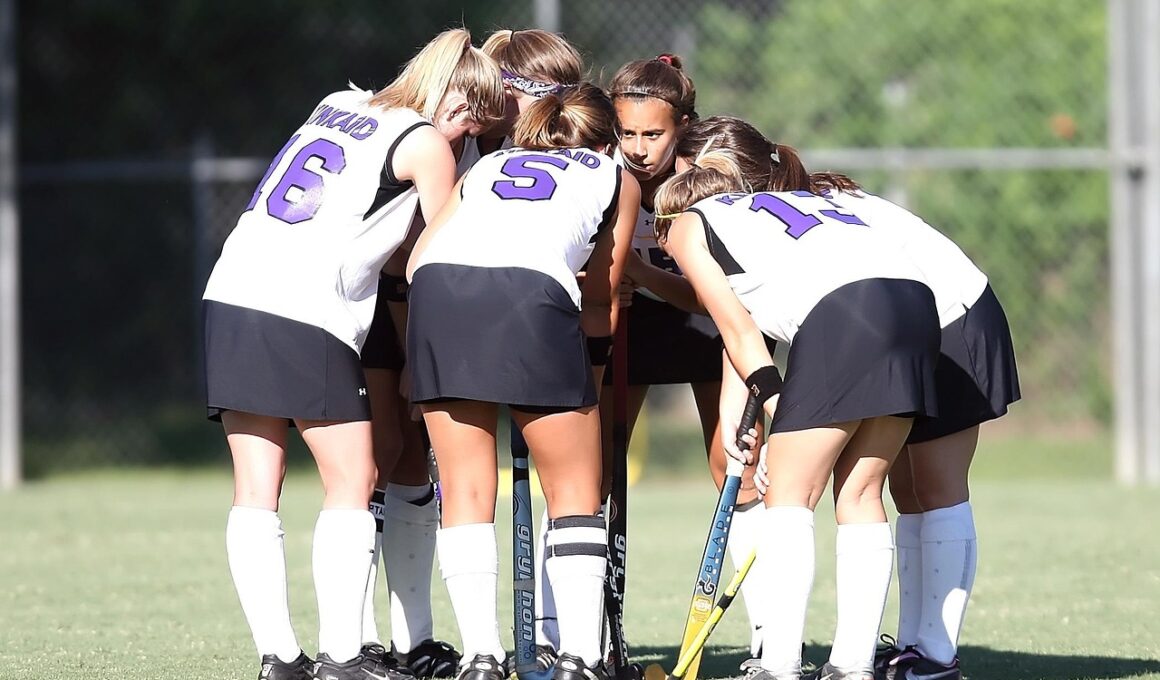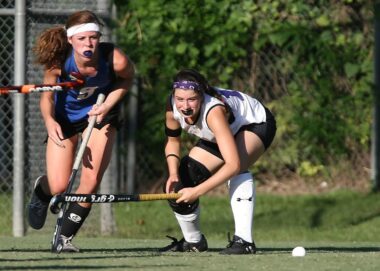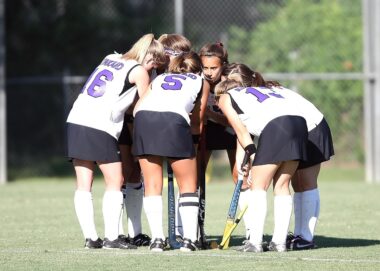Circuit Training for Field Hockey Goalkeepers
Circuit training is an essential component of fitness, especially for field hockey goalkeepers who require a unique combination of strength, speed, agility, and endurance. By using circuit training methods, goalkeepers can focus on sport-specific skills while also improving their overall athletic performance. The structure of a circuit training program must include various exercises that target key muscle groups involved in the sport. These exercises can be tailored to focus on movements that replicates the demands of actual game situations, ensuring that goalkeepers remain sharp and prepared. When developing a circuit training regimen, it is critical to incorporate strength training, cardiovascular workouts, and agility drills. This holistic approach enhances physical fitness and helps prevent injuries caused by overuse or improper techniques. Additionally, incorporating high-intensity interval training (HIIT) into their routine can improve their anaerobic capacity, crucial for the fast-paced nature of field hockey. To summarize, circuit training is beneficial for field hockey goalkeepers, promoting not only physical performance but also mental toughness. Through dedication to a structured program, they can maximize their potential and become invaluable assets to their teams.
In a circuit training program for field hockey goalkeepers, various exercises can be effectively combined to target all essential fitness components. One of the important exercises is the lateral shuffle, which improves agility and speed when responding to the ball. This movement is crucial for goalkeepers when moving side-to-side to block shots or intercept passes. Another effective exercise is the squat, which builds strength in the legs and core, foundational for any goalkeeper’s stability. When combined with dynamic stretches, this strengthens the muscles while enhancing flexibility. Incorporating medicine ball throws not only focuses on building upper body power but also reinforces the coordination necessary for goalkeeping. Each session should have a distinct focus while keeping in mind the goalkeepers’ specific needs. Customizing the exercises ensures that they remain effectively aligned with the athlete’s performance goals. Employing various resistance levels during training can also add variety while maintaining engagement in workouts. Maintaining a diverse training routine helps prevent plateaus and maximizes functional strength development. Therefore, a well-structured circuit training program is essential for goalkeepers striving for peak performance and skill development.
Strength and Conditioning
Strength and conditioning are paramount to achieving the physical demands placed on field hockey goalkeepers. A primary focus should be on building strong lower body muscles since these contribute significantly to the explosiveness required for rapid lateral movement and jump height. Incorporating exercises such as deadlifts, lunges, and plyometric drills increases power output, benefiting goalkeepers who need to react quickly to unpredictable ball trajectories. Furthermore, the core stability exercises like planks and Russian twists strengthen the midsection, ensuring improved balance and agility during gameplay. Upper body strength is also vital, allowing the goalkeeper to effectively clear the ball and withstand impacts. The use of resistance bands can enhance arm strength, promoting better control when managing the stick to block and deflect shots. Proper conditioning will not only improve their ability to perform during matches but also minimize the risk of injury by ensuring balanced muscle development. To achieve comprehensive fitness, equally progressing both strength and conditioning routines tailored specifically for goalkeepers is critical. This emphasis on strength development gives goalkeepers an extra competitive advantage in field hockey.
Agility drills form another significant aspect of circuit training for field hockey goalkeepers. These drills enhance quickness, coordination, and reaction time while effectively simulating the fast-paced scenarios faced during matches. Key agility exercises include ladder drills, cone weaving, and shuttle runs, each designed to improve foot speed and spatial awareness. For example, ladder drills improve foot placement, ensuring goalkeepers can quickly adjust position when facing opposing attackers. Cone weaving focuses on changes in direction, crucial for adeptly positioning oneself during a game. Similarly, shuttle runs develop speed and endurance, training goalkeepers to recover quickly in play. Integrating these agility drills within the circuit will help improve overall performance on the field, ensuring athletes can react appropriately during crucial moments. Additionally, goalkeepers can also benefit from utilizing plyometric exercises such as box jumps to develop explosive strength. Proper form and technique are paramount to achieve the maximum benefit from each drill performed. Therefore, agility training should be balanced with other fitness components for holistic athletic development. Such integration positions field hockey goalkeepers for excellence in performance.
Enhancing Mental Resilience
Mental resilience is an essential skill for field hockey goalkeepers that can be developed using circuit training strategies. Exercises must be designed not only to build physical strength but also mentally fortify the goalkeeper in high-pressure situations. Practicing visualization techniques while training can significantly help, allowing goalkeepers to mentally rehearse successful saves and movements before facing actual shots. Circuit training can incorporate focused breathing practices during breaks to ensure calmness and mental clarity amid the physical exertion. The use of positive reinforcement during training sessions can also bolster their self-confidence, nurturing a mindset geared toward success. Furthermore, implementing situational drills that mimic game scenarios forces goalkeepers to make split-second decisions, fostering mental agility essential for performance. Sharing experiences and challenges with teammates during circuit training can cultivate a sense of community, promoting emotional support and motivation. Keeping the focus on the mental aspect of gameplay, alongside physical training creates well-rounded athletes prepared for the emotional rollercoaster of competitive sport. In a sport like field hockey, having strong mental resilience enhances a goalkeeper’s ability to perform under pressure.
Recovery is a crucial yet often overlooked aspect of circuit training for field hockey goalkeepers. Post-training recovery strategies such as stretching and proper nutrition significantly influence performance during subsequent sessions. Stretching after circuit workouts reduces muscle stiffness, enhancing flexibility and mobility. Active recovery practices, like light jogging or cycling, improve blood circulation, facilitating faster muscle repair. Additionally, adequate hydration to restore lost fluids is paramount in optimizing recovery processes. Furthermore, incorporating rest days into training schedules ensures that the body has an opportunity to heal and strengthen. Techniques such as foam rolling can alleviate muscle tightness and knots, promoting a quicker recovery. To support the body’s recovery, emphasis should be placed on consuming the right nutrients, focusing on protein intake for muscle repair and carbohydrates for energy replenishment. Planning post-workout meals can make a difference in achieving optimal results. Consequently, fostering a consistent recovery routine is just as vital as the training itself, contributing immensely to the overall athletic performance of field hockey goalkeepers. They can perform at their best by focusing on thorough recovery practices.
Final Thoughts
In conclusion, circuit training stands out as a comprehensive methodology for developing field hockey goalkeepers’ skills and fitness. With a balanced approach, conditioning and specific skill development can maximize performance on the field. The integration of strength, agility, and mental resilience builds performing athletes, reducing injury risk while enhancing performance capacity. Customizing training programs to cater specifically to goalkeepers ensures that each athlete meets their development needs. By regularly assessing progress and making necessary adjustments to the workout routines, coaches and players can ensure ongoing improvement and effectiveness. A strong commitment to training alongside effective recovery practices will ensure their growth as athletes. Converted effort in circuit training will directly reflect in a goalkeepers’ capability during high-stakes gameplay. Engaging in a diverse range of exercises ensures they remain adaptable to the on-field dynamics and unpredictable scenarios. Ultimately, circuit training supports producing elite-level goalkeepers who excel in their positions, making significant contributions to their teams. Consistency in training and evaluation fosters not only individual improvement but also builds team synergy on the field.
Moreover, continual education about the latest training methods and technologies should be encouraged among goalkeepers. Keeping abreast of advancements in sports science enhances their understanding of training principles and methodologies. This understanding aids in tailoring their practices to maximize results effectively. Utilizing digital tools and apps can track performance metrics during training and match play, allowing for data-driven adjustments to their training regimens. Analyzing performance trends can help identify strengths and areas for improvement. Incorporating feedback from trainers and sports psychologists can strengthen their mental approaches to gameplay. As the sports community evolves, goalkeepers should remain adaptable to ensure their skills remain sharp. By fostering a culture of learning and openness to new ideas, goalkeeper development can lead to exceptional performance. Coaches play a significant role in facilitating this growth, providing opportunities for goalkeepers to expand their knowledge. Furthermore, maintaining an emphasis on teamwork, communication, and collaboration will enhance their overall development, forging them into leaders on the field. Every training session presents a chance for growth and learning, ultimately leading to successful careers in field hockey.





